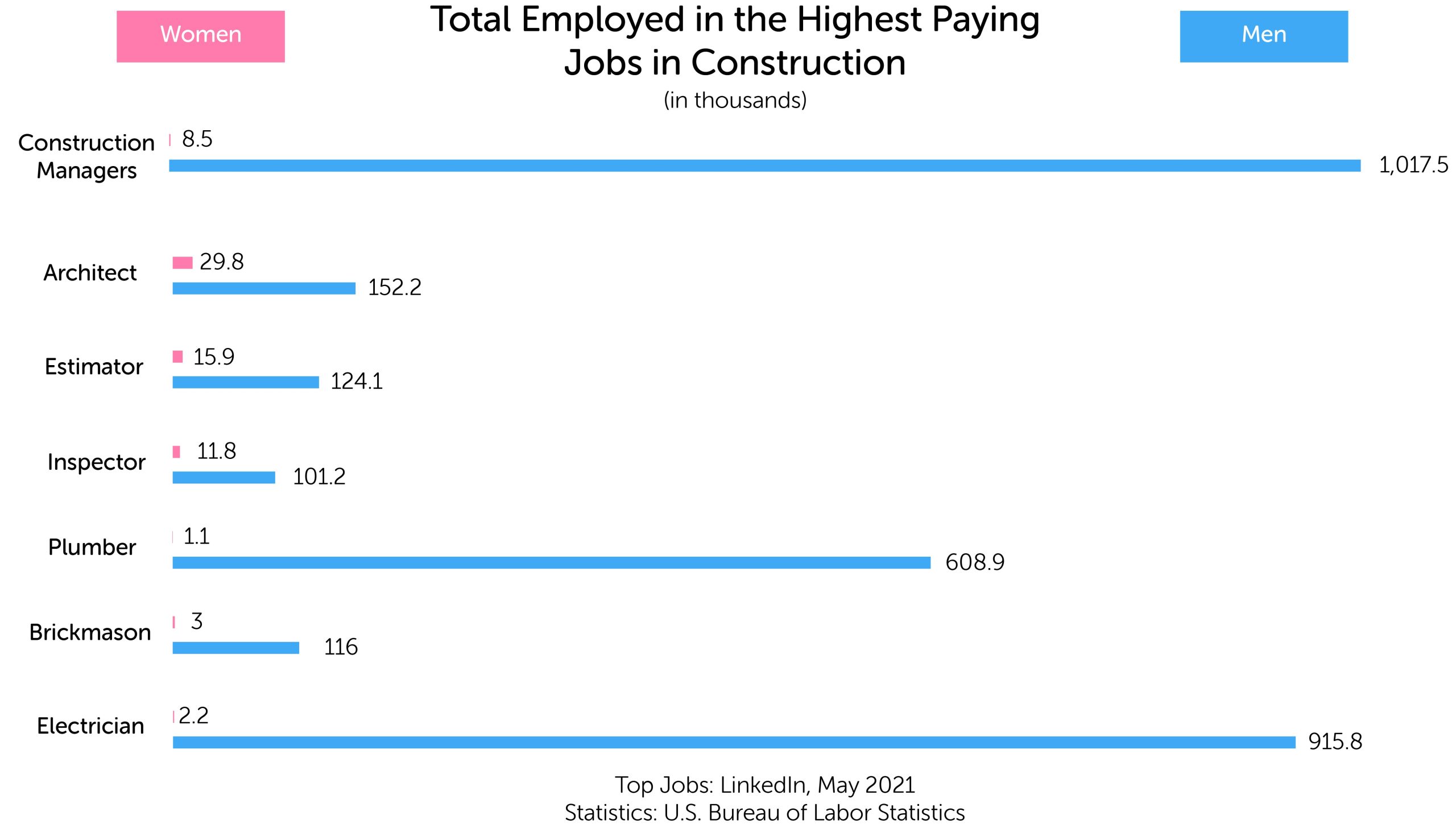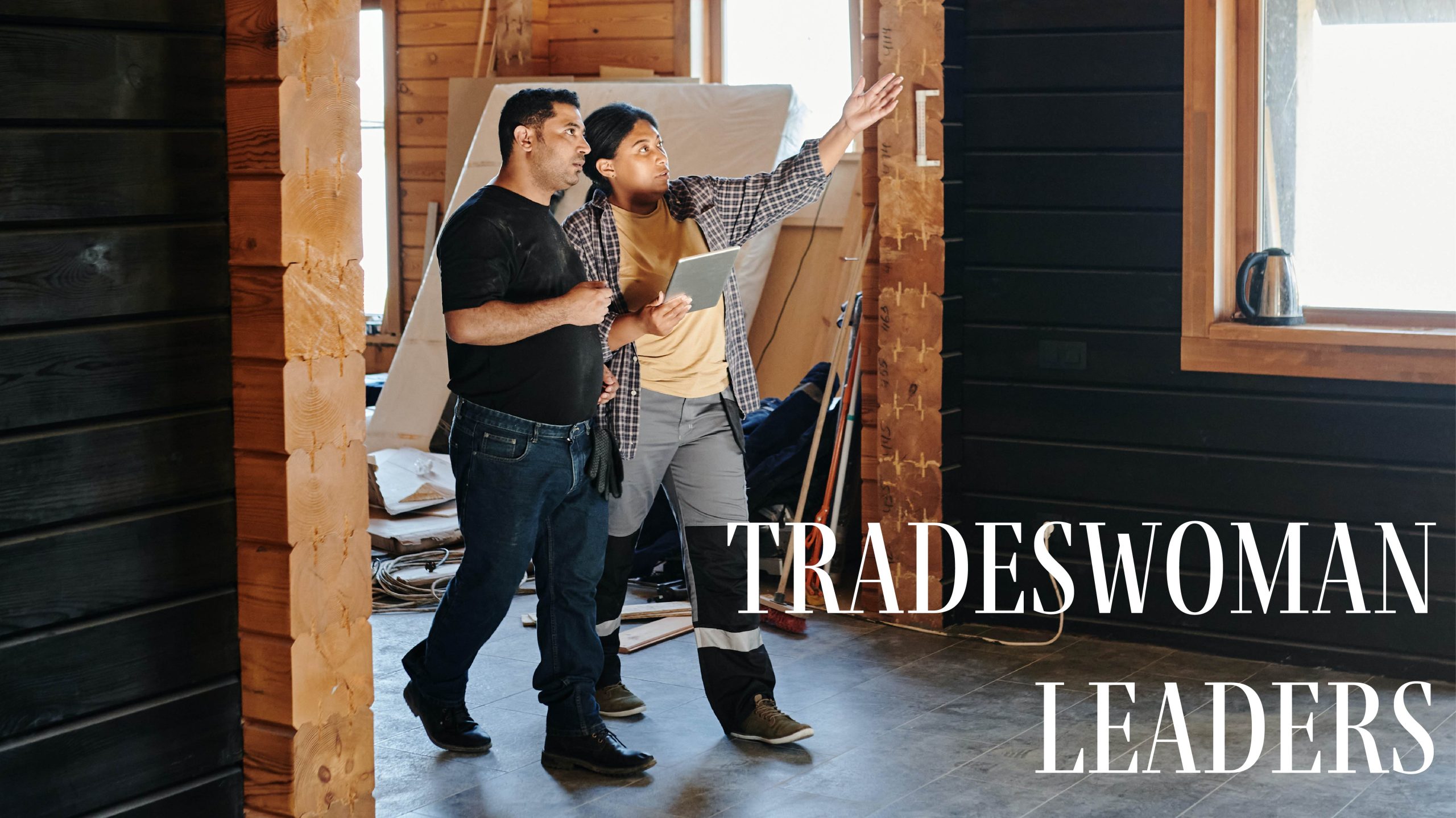Between hammering nails and the gavel finalizing new opportunities, women are gaining the largest amount of recognition than ever before in the most male-dominated industry of the United States. As of December 2022, the construction industry had just under half a million job openings; But, with the rate of women being employed in construction and trades growing every year, it gives hope to companies searching for qualified applicants. Similarly, it has started bringing more attention to the lack of representation and available opportunities for women to industry leading companies and U.S. government officials. With the industry having an average age ranging from 42 to 50 years old, companies are looking for new talent and this generation needs more female role models.
The growth of women employed in construction and trades has been a continuous increase for the last 10 years, from 840,000 female workers in 2012 to 1.28 million in 2022. While some believe that office positions aren’t as crucial to projects as the physical laborers, they would surely notice the difference in how the company ran without them very quickly. 36.1% of management and professional occupations are held by women, along with another 36.1% being in sales. Interestingly, in 2018, only 44% of Engineering New Record’s Top 100 Contracting Firms and Fortune 500 companies had females in executive roles such as Vice President and Director with only 16% of females having C-level positions. While women are fairly present in the office, out in the field is where they are scarce. 24.6% of natural resources, construction, and maintenance jobs are held by women but 2.5% are in trades out of the 10% in the U.S. construction workforce. This leaves us the question of what is stopping them from joining this industry when women make up more than half the country’s population and companies are scrapping the barrel for applicants?
93% of construction firms reported they have open positions to fill, with 91% of them having the same problem of filling at least one craft position. Many explained that this came down to the applicants having little to no skills that were required for the job. How is that possible? Last month, we discussed the importance of CTE programs across the state of Michigan, and how they can open doors for students interested in construction and trades, especially women. For some, being the only girl in a class full of boys learning about a male-dominated industry can be intimidating. It also can lead to fears of harassment, which unfortunately many continue to experience today. In a 2021 study by the Institute for Women’s Policy Research (IWPR), almost a quarter of women have experienced sexual and gender harassment. Although we cannot say it will be okay, there have been large movements to ending these unfair biases and unnecessary actions. Companies are finally being reprimanded for their part in allowing these incidents to occur and continue, while women are taking a stand and banding together to help each other cope and overcome.
Another reason many women stray away from the idea of joining trades is the time commitment. The FPA surveyed a group of women in construction asking, ‘What factors inhibit greater gender diversity in your industry?’ The most popular answers were ‘Retention challenges related to work-life balance’ at 59% followed by ‘Unwelcoming corporate culture for women’ at 57%. Women are often stereotyped to work a simple job that allows them time to take care of the home and children. However, the construction and trades industry is far more demanding than some female-dominated jobs. Depending on contractors and/or projects, it isn’t uncommon for longer shifts or working on the weekends. Respect also plays a major role in not only women’s lives but in everyone’s. If you’re not respected in an environment, chances are you will leave, which is exactly what women are doing in construction. Upon entering, 47.2% say their main reason for leaving the industry was due to the lack of respect and harassment. This statistic is slightly unusual as the same study found that just under 72% of female apprentices found their classroom and formal training experience equal to their male peers. However, as they grow into the industry, this equality diminishes, when in fact, it should be doing the exact opposite.
Another prominent issue is the gender pay-gap. Since women began joining the workforce, their pay has slowly increased to be matched to their male counterparts. In 1980, women made 36% less than men which then increased to 89 cents compared to the man’s dollar pre-pandemic. Currently, the wage gap is at 82.9% for most industries, except construction. Construction is the top industry for women to have the closest opportunity to being paid equal to men at 95.5%. Although, 100% should be the standard, progress is progress. With that in mind, this industry can pay much more than most fields, especially with less schooling that can be paid for with little to no debt. The unemployment rate for women in construction is currently at 3.45%, the lowest it has been in 20 years! However, the amount women can be paid also has few factors such as pregnancy and maternity leave. According to the UT Southwestern Medical Center, it is highly advised to avoid lifting anything over 20 pounds while pregnant, especially if the woman is not accustomed to proper form and technique with a changing body. Following the child being born, having childcare readily available is not a common practice in construction due to the dangers on every site. Over 38% of women with children found this reason alone to be a very important factor in them leaving the trades along with lack of breastfeeding support and wanting to spend more time with their kids as they grow up.
So, what do women bring to the table they are helping to build? For starters, they bring profit. Companies with the highest percentage of women in executive management roles are, on average, 47% more profitable than those with the lowest. Similarly, companies with more female presence on their boards are 32% more transparent, which in turn creates more trust in customer relationships and networking. It has also been found that companies with greater gender diversity are more environmentally friendly in terms of their energy consumption, GHG emissions, and water usage regarding the field and office. There has also been initiatives set like that of U.S. Secretary of Commerce, Gina Raimondo, who spoke at the NABTU Tradeswomen Build Nations 2022 Conference in October 2022. She explained the need for jobs filled in the construction industry, and that there are plenty of women ready and willing to fill those. She announced her goal of doubling the number of women employed in construction from 1 to 2 million in the next ten years, which is very possible to do in lesser time with the current rate.
There has also been changes to the inclusion of women in the industry, such as personal protective equipment (PPE). If a worker is wearing ill-fitted PPE, it can cause harm to them and potentially death should it be caught in a piece of machinery or material. Skanksa, a multinational construction and development firm, took this matter into their own hands and have started creating PPE that fit women properly. Typically, PPE is made to be a ‘one size fits all’ which ultimately fits more men comfortably than women. Skanksa brought women in from their field to help with the design and creation of new work vests and gloves. With these changes, women in the field now have more faith that their equipment is safe, allowing them to work with less worry and more concentration on the job to be done.
Currently, there are thousands of women who are role models to younger girls. However, more times than not, they are hidden inside the office, and overlooked if they’re not actively in the field. Construction Dive made a list of women in construction that were nominated for a spotlight. The lists include women of all ages, races, occupations, trades, and backgrounds. To start bringing more women into the industry, women need to start seeing that great success is a possible outcome for them in a challenging industry at all levels.
There are also women in construction that many may not even realize but see often. Barbra Kavovit is currently a leading lady on the popular show Real Housewives of New York, but off-set she is busy running one a New York construction company, Evergreen Construction. She has also recently published her third book, Heels of Steel, which tells the story of a girl who grows up interested in construction and continues to pursue her dreams throughout adulthood. It gives insight to the many obstacles women face in the industry and to what Kavovit fought through herself. With the theme for this year’s National Women in Construction Week being ‘Many Paths, One Mission’, the industry needs to begin opening doors that have just been cracked. Many women are on different paths of life but have the same mission of providing for themselves and their families, just like their male coworkers. It also goes for companies of different trades and locations having the goal of growing their gender diversity to not only improve their staffing hardships but also their profits and environmental footprint.
Share this Post








